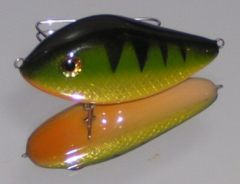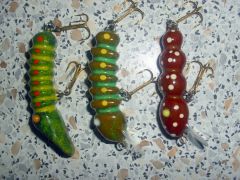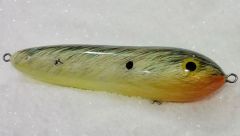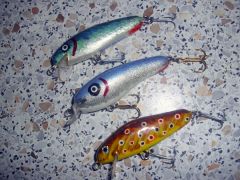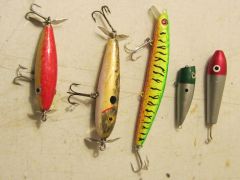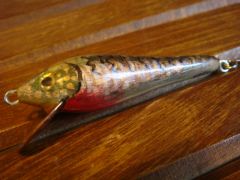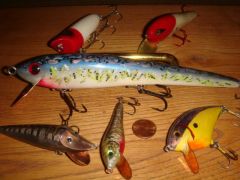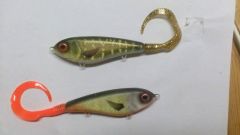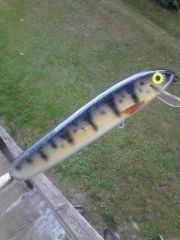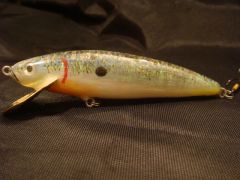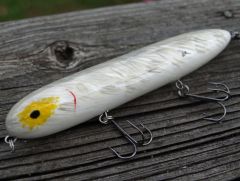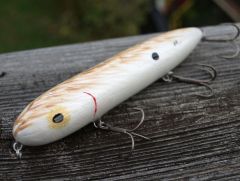-
Posts
1,131 -
Joined
-
Last visited
-
Days Won
9
Content Type
Profiles
Articles
TU Classifieds
Glossary
Website Links
Forums
Gallery
Store
Everything posted by littleriver
-
@ Jr I do not think the areas where arrow are will be a problem. But the nose and tail of both baits will be a problem. They really need to be rounded off like Ben is talking about. If possible the whole bait should be rounded of like the belly of the bait without arrows. Epoxy will flow away from sharp edges leaving them unprotected. I am still learning with the superglue. Experience has taught me to use a fine sandpaper between coats of superglue. Two is the number of coats i use on everything but I think more may help fill more spots. Two leaves a decent surface. The smoother the surface one can get before paint the better. @Ben When you add the epoxy after superglue, do you install bill and hangers first? If not, how do you keep the epoxy out of the holes?
-
-
-
-
-
-
-
-
-
First consideration always is what do want from the bait. Topwater/ diver? Then , what sort of action do you want? Fast / slow? Here we want topwater and we want walk the dog . That means keep it light and tail weight the bait. How much and exactly where will be determined by lure shape, wood used and where you hang your hooks. I used the super spook to guide me on this build. I liked the action of the bait. So, I placed one in a bowl of water . Next, I weighted my bait to sit the same in the water.
-
I caught some nice fish on a five inch bone colored super spook with them on it . I did not color them and the water was dirty. But they did their job beautifully. Have to say I had my doubts till the fish started biting....... This was my first experience with them.
-
Hi Bill Thanks!! All the spooks I have put in the gallery so far are 5 1/4 inches and have a bit more taper on tail than nose. And none on the body. This bait is 4 1/2 inches long and much smaller in diameter Plus it has a taper starting at head and goes all the way to the tail. So this one is different. But works equally well. Weighting of these is critical.
-
@Pickadoll I second that "Perfect" . The bait is still gliding while waiting for the next twitch. Seems an eternity. Really good i think. They don't call it a glide bait for nothing. I have to wonder how long it would glide without the tail. Thanks for sharing!
- 137 replies
-
- glide bait
- weighting
-
(and 2 more)
Tagged with:
-

New Guy, A Bit About Me And I Posted Pics In Gallery
littleriver replied to bluewaterspecial's topic in Hard Baits
Hello Ryan Really enjoyed seeing your work. I am inspired. Very interesting about your grandfather. Seems you have a talent for the arts too. Hope you decide to stay around a while; looking forward to seeing what you make next. Vic -
-
The devil is in the details. Some take minutes, while others take years to learn. But we all have to start somewhere...............how much of it is understood................well we all have our limits. Designing and copying are two different animals. I started out thinking i wanted to design my own bait and quickly learned I needed to do some copying. After learning much and making nothing from the baits I have copied, i am now making a few of my own design. These baits are in the gallery now and have design features that are known only by me. As much as I would like to share them all, I think it would not hurt that folks learn a few on their own. Sadly, I am still not making any money. Keep whittlin away at it.....
-

handmade wood muskie/bass bait yellow perch
littleriver commented on crankpaint's gallery image in Hard Baits
-
-
-
You can put that second coat on immediately. I would not thin . Leave it thick so it will cover well. Check surface closely under good light to be sure no spots are missed and surface appears even.
-
@mark I found line tie position to be a critical element. My two weight glider in the gallery was dead stick on initial swim but after moving the line tie it was the action I was after. By movement of tie, I mean up and down. Most of the two weight glider baits in the link Dieter provided have the ballast at the extreme ends of the bait. When this is done the ballast naturally gets closer to the line tie position because the bait is narrowest at it's ends. When the ballast is too much in line with the line tie, the bait would not turn. Certainly moving ballast will fix the problem but so will moving the line tie.
- 137 replies
-
- glide bait
- weighting
-
(and 2 more)
Tagged with:
-
-




